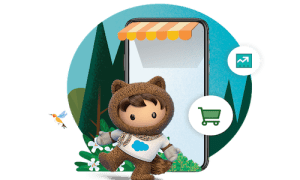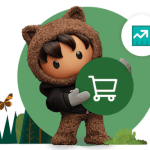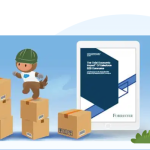B2B e-commerce is suddenly a hot topic in the new climate. E-commerce has been a disruptive force for years. Just take a walk through any city centre and look at how brick-and-mortar stores are faring. More and more businesses are moving online.
The pandemic highlighted the utility of strong digital channels. Especially for B2B buyers, unaccustomed to doing business on the digital frontier. Now, these buyers are as digitally savvy and hyper-connected as B2C customers. On top of that, they expect to receive the same level of customer service. This means that selling on a website isn’t enough. B2B organisations need to up their digital game to compete in the New Normal.
One of the best ways to improve e-commerce is to create an omnichannel experience that seamlessly carries users across touchpoints. This is becoming standard practice in B2C. However, for B2B organisations, omnichannel engagement still has the potential to provide an advantage over slower-moving competitors.
Let’s take a look at the meaning of B2B e-commerce and how organisations can create an effective B2B e-commerce strategy to drive sales.
What is B2B ecommerce and why does it matter?
B2B e-commerce — or business-to-business e-commerce — utilises online platforms to carry out transactions between businesses. B2B hasn’t relied on e-commerce to the same degree as B2C (business-to-consumer). So most B2B organisations haven’t felt the same pressure to prioritise their digital sales channels.
When it comes to creating exceptional customer journeys, many B2B companies are a step behind. Businesses can’t afford to stumble in today’s climate, even if e-commerce still accounts for a relatively small slice of the B2B sales pie.
According to a Forrester Report, 73% of today’s sellers use an e-commerce or online sales portal — with an average of 27% of revenues coming from these channels. This is set to increase suddenly and drastically, as 83% of businesses say they plan to increase e-commerce sales in the next three years.
The companies that are focussing on growing their e-commerce platform will be well prepared to face the future: cross your fingers for the other 17%.
B2B customers demand B2C customer experiences
Many B2B organisations have turned their eye towards creating the streamlined, customised experiences that B2C customers have grown accustomed to. Today’s customers want to be able to engage with a business wherever and whenever they please. The modern B2B buyer is getting younger, as well.
According to a Merit report, 73% of millennials purchase products or services for their companies. Typically, these younger buyers:
- utilise more online resources when researching products
- turn to peers for recommendations
- use social media to check out vendors, products, and solutions.
For B2B sellers, creating an online presence in the places where buyers tend to spend their time is paramount. But how can B2B businesses manage to be everywhere at once? How can they remain sleek, agile, and responsive while maintaining an outsized presence? Simple; focus on creating an omnichannel strategy, and then bring it to life with Salesforce.
Embrace an omnichannel strategy
An omnichannel experience offers users seamless interactions across a range of connected channels, which can include social media, websites, brick-and-mortar shops, chatbots, email, and more. In multi-channel experiences, these various channels operate in silos, but an omnichannel strategy unites them to provide a more holistic journey.
Examples of businesses offering exceptional omnichannel experiences:
- Amazon not only lets users access their account through their website, but also through mobile apps, its voice-activated Alexa device, smartwatches, tablets, and more. Need to reorder something? No problem: ask Alexa, set up a recurring delivery through an app, or pop by one of their brick-and-mortar locations.
- Disney connects its mobile-ready website with trip-planning tools, an app that provides visitors with attraction info and wait times, and its MagicBands — wristbands that act as hotel keys, charge cards, and entrance passes.
- Starbucks offers an omnichannel experience that’s second to none. Customers get a free coffee when they join Starbucks’ loyalty programme. Customers can then top-up their loyalty account via phone, in-store visits, on the website, or in the app.
Creating an omnichannel strategy is all about breaking silos, unifying data, and putting the customer at the heart of everything. Simply put, it’s about connection. This has long been the focus of B2C, but it’s evident that it’s the future of B2B as well.
According to the Forrester report, a third of B2B sellers have already implemented an omnichannel strategy, and most of the remaining businesses are now taking steps to do so. For B2B organisations looking to future-proof their organisation while also gaining a competitive advantage, this is the perfect time to create an omnichannel strategy.
Engage customers with B2B e-commerce technology
Creating an omnichannel experience takes more than the right strategy — it also takes the right toolkit. According to Forrester, less than 50% of surveyed B2B organisations are meeting best practices for people, processes, technology, and culture. B2B leaders need to formulate their strategy, get the right team on board, and use the correct technology to implement their ideas.
Luckily, Salesforce offers digital solutions to help B2B organisations better connect their employees – and better connect with their buyers.
Two Salesforce solutions that can help boost B2B e-commerce channels:
Commerce Cloud: A Salesforce solution designed specifically for the challenges of B2B, Commerce Cloud helps simplify B2B e-commerce complexities. Commerce Cloud enables businesses to:
- Improve their speed to market
- Stay up to date, with thrice-a-year updates
- Automate repetitive manual tasks and provide sales teams with real-time customer data
- Create intuitive, self-service shopping experiences — anytime, anywhere, and on any device
- Support contract pricing, account hierarchies, reordering, and custom catalogues
- Build intuitive digital portals and branded sites
Marketing Cloud and Pardot: Once Commerce Cloud is in place, B2B organisations can turn to Marketing Cloud to better reach their buyers. Marketing Cloud’s Pardot is a marketing automation tool designed with B2B in mind.
With Pardot, B2B companies can empower sales teams, generate better leads, close more deals, and build more meaningful connections. And as we know, today’s business landscape is all about connecting.
The future of B2B e-commerce
It’s a fact that the expectations of the B2B buyer have increased, as 83% of buyers now expect companies to use technologies to improve experiences. This shouldn’t be looked at as a problem but as an opportunity.
A rising tide lifts all boats, after all, and exceptional customer journeys will carry us to exciting new places. For B2B sales e-commerce, the arrow is pointing up.
To read more about how B2B e-commerce is changing, download the Forester Report, “B2B Embraces Its Omnichannel Commerce Future”.




















